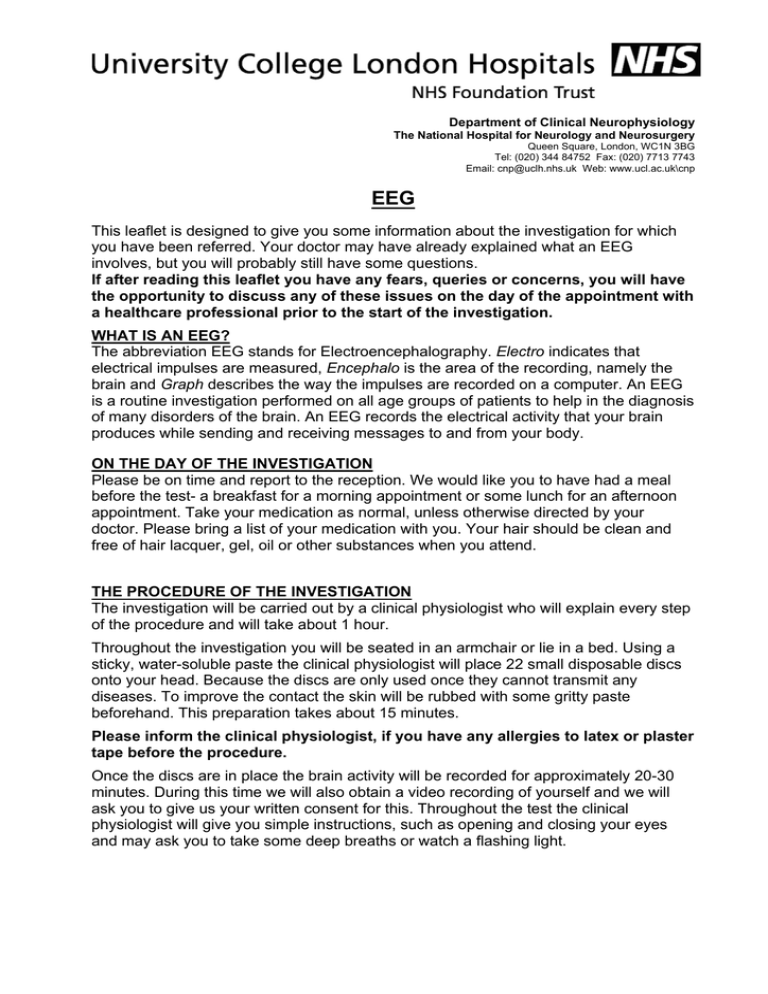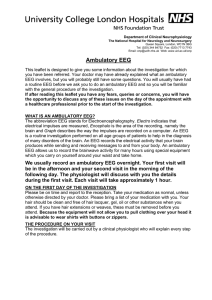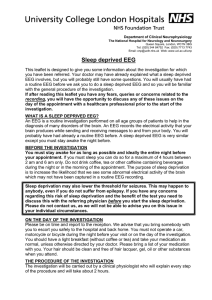Department of Clinical Neurophysiology The National Hospital for Neurology and Neurosurgery
advertisement

Department of Clinical Neurophysiology The National Hospital for Neurology and Neurosurgery Queen Square, London, WC1N 3BG Tel: (020) 344 84752 Fax: (020) 7713 7743 Email: cnp@uclh.nhs.uk Web: www.ucl.ac.uk\cnp EEG This leaflet is designed to give you some information about the investigation for which you have been referred. Your doctor may have already explained what an EEG involves, but you will probably still have some questions. If after reading this leaflet you have any fears, queries or concerns, you will have the opportunity to discuss any of these issues on the day of the appointment with a healthcare professional prior to the start of the investigation. WHAT IS AN EEG? The abbreviation EEG stands for Electroencephalography. Electro indicates that electrical impulses are measured, Encephalo is the area of the recording, namely the brain and Graph describes the way the impulses are recorded on a computer. An EEG is a routine investigation performed on all age groups of patients to help in the diagnosis of many disorders of the brain. An EEG records the electrical activity that your brain produces while sending and receiving messages to and from your body. ON THE DAY OF THE INVESTIGATION Please be on time and report to the reception. We would like you to have had a meal before the test- a breakfast for a morning appointment or some lunch for an afternoon appointment. Take your medication as normal, unless otherwise directed by your doctor. Please bring a list of your medication with you. Your hair should be clean and free of hair lacquer, gel, oil or other substances when you attend. THE PROCEDURE OF THE INVESTIGATION The investigation will be carried out by a clinical physiologist who will explain every step of the procedure and will take about 1 hour. Throughout the investigation you will be seated in an armchair or lie in a bed. Using a sticky, water-soluble paste the clinical physiologist will place 22 small disposable discs onto your head. Because the discs are only used once they cannot transmit any diseases. To improve the contact the skin will be rubbed with some gritty paste beforehand. This preparation takes about 15 minutes. Please inform the clinical physiologist, if you have any allergies to latex or plaster tape before the procedure. Once the discs are in place the brain activity will be recorded for approximately 20-30 minutes. During this time we will also obtain a video recording of yourself and we will ask you to give us your written consent for this. Throughout the test the clinical physiologist will give you simple instructions, such as opening and closing your eyes and may ask you to take some deep breaths or watch a flashing light. EEG page 2 DEEP BREATHING (HYPERVENTILATION) This is a usually performed during an EEG, as it can produce changes in brain wave activity that help in the diagnosis. Deep breathing is not done: if there is a history of heart or chest disease in patients with epilepsy who have not had a seizure for more than 12 months. OBSERVING FLASH LIGHTS (PHOTIC STIMULATION) This is a routine procedure of the EEG as it can also produce changes in brain activity that help in the diagnosis. You will be asked to look at a bright light which flashes at different rates. Photic stimulation is not done: in patients with epileptic seizures that have only occurred at night for 3 or more years. in patients with epilepsy who have not had a seizure for more than 12 months. There is small chance that deep breathing or flash lights can trigger a seizure in susceptible individuals. The clinical physiologist will discuss these parts of an EEG with you and neither will be performed, if you feel uncomfortable or concerned about them. AFTER THE INVESTIGATION When the investigation is finished, the discs are removed without any pain. You may then continue immediately with your normal activity. There may be some small amount of paste left in your hair which will wash away with shampoo. RESULTS OF THE INVESTIGATION The results of the test will not immediately be available for you because the recordings need to be studied by a physician. He or she will write within a few days to your consultant who will then discuss the findings with you. FREQUENTLY ASKED QUESTIONS: Is the test painful? No. Slight discomfort may be felt when the scalp is rubbed. Will electrical shocks be applied? No. We are only recording electrical activity that your brain produces naturally. Are needles involved? No Can you read my mind? No. This is not a psychological test. We are only recording electrical impulses and not thoughts. Can I wear jewellery? Yes. This has no effect. Occasionally earrings may have to be removed.



